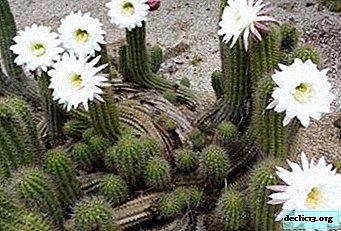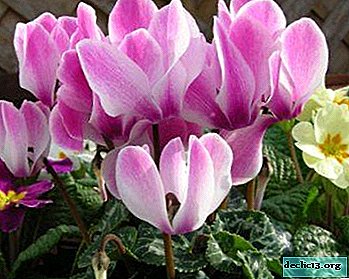Prickly beauty - trichocereus

The most unpretentious plant that can be grown at home is considered to be a cactus. It rarely needs to be watered, it calmly perceives various weather conditions.
The main thing is that cacti do not take up much space and perfectly purify the air. Although for those who want exotic, you can choose an unusual cactus - trichocereus.
In the article you will see a photo of the main types of cactus. You will find out what kind of care a plant needs, how to grow it in open ground. We also consider the methods of propagation of trichocereus and the process of its flowering.
Botanical Description
This type of cactus came to us from South America. Today it is widely distributed in indoor floriculture, it is quite famous in Russia.
Got its botanical name from the Greek word "trichos", which means hair. This is an upright cactus, which is now noticeably different from its "ancient" counterpart. It is scientifically called "Echinopsis peruviana".
Trichocereus has a wide trunk, in diameter it can be up to 16 centimeters, and in height from 20 centimeters to 3 meters. On the trunk of it there are no more than 12 ribs, on which there are thorns that can grow up to 10 centimeters in length. It blooms with white flowers, which have a pleasant aroma, flowers grow in length up to 10-25 centimeters. In some species, they bloom only at night, but in indoor varieties, flowers appear extremely rarely.
The cactus was first mentioned by the monks who settled in Peru in 200 BC. They made a special drink from trichocereus, which was called "ahuma" - this ritual potion was used to determine the illness of the patient. Later, the plant spread to Ecuador, Bolivia, Argentina and Chile. Then it came to Europe, and in the 20th century, the plant became widely used as an indoor cactus.
Certain types of trichocereus are poisonous, they contain alkaloids and can cause paralysis of the central nervous system.The main types and their photos
There are several well-known types of cactus, some of which are usually grown at home.
Whitening (Trichocereus Candicans)

One of the most famous types of cactus. It has a very bright green stem, its slight curvature is permissible. The thorns on it grow in length from two to seven centimeters. The thorns themselves are yellowish or with a white tint, straight and quite sharp. A cactus has flowers - white in the form of funnels up to 12 centimeters in diameter and 20 centimeters in length. They smell something like a lily. The fruits are large, oval and red.
San Pedro (Pachanoi)

This cactus is also called "colloidal" and it comes from the genus Echinopsis. But it is customary to call it the San Pedro cactus.
The cactus grows in height to six meters, has many shoots. In width, an adult cactus has up to eight ribs, on which five to seven spines of brown or dark yellow are placed. Spines in length are up to two centimeters. The flowers of the cactus are white, have the shape of tubes, up to 23 centimeters in length, and the tube itself has black hairs. Such a cactus grows quickly, it is not customary to grow it in a room.
Poison Peruvian Torch (Peruvianus)

View of a fast-growing cactus brought from the Andes. Outwardly, it practically does not differ from the San Pedro cactus, the only difference is the dark spines and grows much higher than its relative.
The Peruvianus cactus also has a lot of mescaline, which is considered a poisonous and narcotic substance.Lump (Thelegonus)

He has a dark green stalk, which seems to creep and slightly lifted. Wherein in length, the cactus reaches up to two meters, and in width up to 8 centimeters. It has spines up to one and a half centimeters long. In the center is one stiffer spine, which has up to 4 centimeters in length. The spines are yellow to gray and black. The flowers grow white and large, the fruits are red up to 5 centimeters long.
Large Angle (Macrogonus)

The stems have a bluish-green hue. The cactus has sharp spikes 1.5 centimeters long, the central spine can reach up to three centimeters. Spines are dark gray or dark brown. The flowers are white, in diameter up to 10 centimeters. Fruits in the form of balls, five centimeters in diameter. Its seeds are large and glossy. It is considered the best breeding cactus.
Shpakha (Spachianus)

It is a tree-like cactus. At the age of four to five years, processes arise on the stem, growing parallel to the main stem. Spines are golden in color, the stem is ribbed light green. Indoor flowering is almost impossible to achieve this type of floweringbut in greenhouses blooms with white flowers up to 15 centimeters in diameter. This type of cactus is often used as a stock for weaker species.
Terscheck (Terscheckii)

This plant reaches up to twelve meters in height and up to forty-five centimeters in diameter. Ribs from eight to fourteen cm. Yellow spines from eight to fifteen centimeters in length. His flowers are white, long - up to 20 centimeters. The spines are dark and long.
Bridges (Bridgesii)

It has a gray-green trunk with whitish stripes, reaches a height of 4 - 5 meters. He has blunt ribs with yellowish spines from 8 to 10 centimeters long. In room culture, it is practically not common, since it is very high. Has whitish-yellowish flowers, up to 20 centimeters long.
How to care at home?
Some varieties of cacti can be grown at home. To do this, pay attention to care.
Temperature
In summer, the cactus is unpretentious and easily adapts to the absence of the sun, and in the heat practically does not dry out. It is recommended to keep it at the optimum temperature - twenty-twenty-five degrees Celsius. In winter, the cactus needs a cool and ugly room, the temperature is about ten degrees. A sharp change in temperature is not allowed, since the plant is in some "hibernation".
It is important to pay attention to the fact that the plant does not get cold and does not stand next to heating appliances.Watering
Trichocereus is watered with restraint, as he does not like excessive moisture. The cactus needs abundant watering at the moment of active growth - from spring to autumn. Water should be at room temperature and soft, you can not water it with cold water, as the plant can "get sick". In winter, you need to water less often, and in especially cold months, up to once every three to four weeks.
Shine
Cacti love light, so they can be safely put on the window for the whole day. In a very dark room, they begin to dry out, and the flowers on them begin to wither. Therefore, it is recommended to ensure that cacti are turned as often as possible facing the sun.
Priming
Trichocereus grows best in alkaline soil. Various soil compositions are also excellent, which include: sand, peat, perlite, garden soil, crushed pumice, gravel, compost.
Pruning
 It is produced only if the plant is ill with something. To do this, you need:
It is produced only if the plant is ill with something. To do this, you need:
- take special garden shears;
- carefully trim the damaged areas, but in no case touch the trunk of the plant;
- it is advisable to treat the cactus with special solutions for recovery;
- pruning can only be done in spring.
Cactus is also often pruned for its further rooting in order to renew the plant. With this pruning, you should not place a freshly cut plant in water or a substrate - a high probability of decay.
Top dressing
The best "nutrient" substances are fertilizers based on phosphorus and superphosphate. It is also recommended to use lime, but you can not combine it with acidified soil and alkaline fertilizers. It is traditionally better to use fertilizers in dry form, but you can add a little concentrate.
Pot
For planting, a medium-sized clay pot is recommended. The cactus should be spacious, it is necessary that there is room for further growth. If the cactus grows strongly, then it must be transplanted into a larger pot.
It is recommended to avoid a plastic bucket, and use natural materials.Transfer
Trichocereus needs a transplant every two years, even if the plant is already at a respectable age.
- you need to buy a wider flower pot;
- add substrate and superphosphates to it;
- crushed pieces of old plaster can be added to the ground;
- gently dig a plant from an old pot;
- put in a new one, tack the ground;
- water it;
- add a little concentrated fertilizer with a spray to the plant itself.
Wintering
The plant hibernates during the winter period, so it is not recommended to water it often. It is enough to wipe it with a damp cloth, make sure that the soil does not dry out much. In winter, cactus is susceptible to various diseases that are caused by a lack of nutrients.as well as too cold air. Observe the room temperature and the temperature of the water that the plant is watered.
Outdoor cultivation
 Often large breeds of cactus are used as decoration and are planted in open ground. In order for trichocereus to take root, you need to carefully choose the methods of planting and care.
Often large breeds of cactus are used as decoration and are planted in open ground. In order for trichocereus to take root, you need to carefully choose the methods of planting and care.
Particular attention should be paid to the soil. Good soil is a significant factor in the growth of cacti. Trichocereus loves porous alkaline soil.
Standard cactus land is suitable, but can be improved by adding one part of bone meal or pumice. Trichocerus has a rich root system and many processes, they need space and undesirable close proximity to other plant species. Watering in open ground is not necessary often, especially if there are other sources of moisture. And to cover the plant from the sun is not necessary at all, it quickly gets used even to the scorching sun's rays.
Breeding
There are two types of planting of this cactus - with the help of seeds and stem cuttings.
Stem cuttings
- Cut the stalk.
- Dry the cuttings for several days in the pantry or in another dry, dark place.
- Add a moist substrate to the planting site and moisten the soil.
- Plant a plant in it.
Seeds
Growing trichocereus from seeds requires good soil.
- It is necessary to choose sandy soil with proper drainage.
- Use small ceramic pots for germination.
- The temperature during germination should be up to 30 degrees Celsius.
- Through the drainage, stretch small cotton wicks and lower them into a container of water.
- From above, the drainage should be covered with soil and put the seed of a cactus in the center.
- The seed must be sprinkled with a small amount of earth.
- The pot should be placed in a transparent plastic container with a lid.
- It needs to be exposed.
- It is necessary to water as the soil dries with the help of a spray gun.
Bloom
 Each species of trichocereus blooms at different times.. It must be remembered that in winter most of the trichocereus are in hibernation.
Each species of trichocereus blooms at different times.. It must be remembered that in winter most of the trichocereus are in hibernation.
Therefore, the appearance of flowers can be detected in spring or summer.
The flowers of each species are also different. Mostly they are white and tubular in shape, and some smell like lilies.
The flowers fall fast enough, so do not try to save them.
After flowering, it is enough to remove the fallen leaves and, if the time has come, you need to transplant the plant into another soil.
Pests and diseases
Diseases are the result of improper cactus care. The main pest that annoys trichocereus is the mealybug. It is necessary to fight it with the help of insecticides, which are evenly sprayed along the trunk of the plant.
Similar plants
Many cousins are similar to trichocereus cactus. Among them:
- Sethehinopsis;
- Gymnocalycium;
- Ariocarpus;
- Cephalocereus
Conclusion
Trichocereus is a plant that feels great both at home and in the wild, the main thing for its growth and flowering is a temperature in the region of 20 degrees, abundant but reasonable watering, as well as comfortable soil with alkaline soil.

















